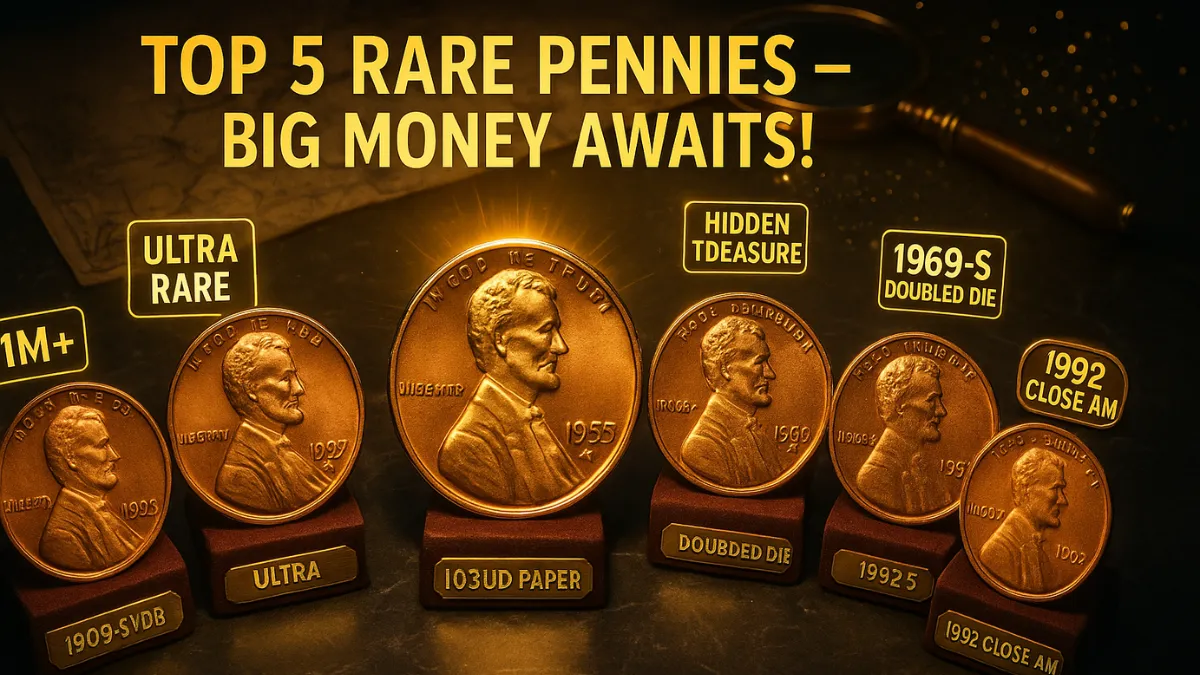Imagine finding a penny in your pocket that could pay off a house. The Lincoln penny, a staple of American currency since 1909, has produced some jaw-dropping rarities, particularly from the years 1961, 1964, 1966, 1970, and 1971.
These coins, often overlooked, can be worth hundreds of thousands due to mint errors, pristine condition, or unique varieties. Let’s dive into the fascinating stories behind these valuable pennies and why you should check your change today.
The Lincoln Penny: A Brief History
Introduced in 1909 to honor Abraham Lincoln’s 100th birthday, the Lincoln penny was the first U.S. coin to feature a real historical figure. Its obverse showcases Lincoln’s profile with “In God We Trust” above, “Liberty” to the left, and the mint year to the right.
From 1959 to 2008, the reverse featured the Lincoln Memorial, replacing the earlier wheat ears design. Most pennies are composed of 95% copper and 5% zinc, giving them their iconic reddish-brown hue. Billions were minted, but certain years stand out due to rare errors and high-grade specimens.
1961 Lincoln Penny: The $242,000 Cent
In 1961, the U.S. Mint produced millions of pennies at Philadelphia (no mintmark) and Denver (marked with a “D”). Most are common, but rare errors like doubled dies—where text or numbers appear duplicated—or off-center strikes make some extraordinary.
Condition is key: coins graded MS65 or higher by PCGS or NGC, especially with errors, are highly sought after. One flawless 1961 penny with a rare error sold for an astonishing $242,000 at auction, proving that a single cent can become a collector’s treasure.
1964 Lincoln Penny: A $232,000 Time Capsule
With over 10 billion pennies minted in 1964, you’d think they’re all ordinary. However, errors like double die obverses, off-center strikes, or wrong planchet strikes set some apart. The 1964 penny, one of the last made of 95% copper, marks the end of an era.
A pristine, error-marked 1964 penny fetched $232,000 at auction, driven by its rarity, condition, and historical significance. Check those old jars—you might hold a piece of Cold War-era history worth a fortune.
1966 Lincoln Penny: The $222,000 Surprise
Minted in huge quantities, the 1966 penny seems unremarkable, but flawless Philadelphia coins (no mintmark) or those with errors like double dies are collector’s gold.
High-grade specimens, especially MS67 or above, are rare due to circulation wear. One exceptional 1966 penny, perfectly preserved with no imperfections, sold for $222,000. Its value lies in its pristine condition and the thrill of finding a hidden gem in everyday change.
1970 Lincoln Penny: The $220,000 Small Date
In 1970, over 1.1 billion pennies were minted, primarily in Philadelphia and San Francisco (marked with an “S”). The San Francisco small date variety, with a compact font, is particularly rare, especially in proof sets.
Errors like wrong planchet strikes or double dies elevate value further. A 1970-S small date penny, perfectly preserved with a rare error, sold for $220,000, showcasing how a minting mistake can turn a penny into a masterpiece.
1971 Lincoln Penny: The $210,000 Hidden Treasure
The 1971 penny, minted in Philadelphia, Denver, and San Francisco, saw billions produced. However, San Francisco proof coins with errors like double dies or off-center strikes are prized.
High-grade coins (MS67+) with unique flaws are rare due to heavy circulation. One remarkable 1971 penny, with a dramatic double die and flawless condition, sold for $210,000. This coin proves that even the most common-looking penny can hide immense value.
Why Are These Pennies So Valuable?
The value of these pennies comes down to three factors: rarity, condition, and demand. Mint errors like double dies, off-center strikes, or wrong planchets create unique coins.
High-grade coins (MS65 or above) are scarce due to wear, loss, or melting. Collectors’ passion for American history and the thrill of the hunt drive demand, pushing prices to staggering heights at auctions.
Start Your Treasure Hunt Today
These stories remind us that treasure can hide in plain sight. That dusty coin jar or forgotten drawer might hold a 1961, 1964, 1966, 1970, or 1971 Lincoln penny worth thousands.
Inspect your coins for mintmarks, errors, or pristine condition. Professional grading by PCGS or NGC can confirm a coin’s value. So, grab a magnifying glass and start checking your change—you never know when a penny could change your life.
FAQs
What makes a Lincoln penny valuable?
Rare mint errors, high-grade condition (MS65+), and collector demand drive value. Errors like double dies or wrong planchets can make a penny worth thousands.
How can I identify a rare 1970 penny?
Look for the 1970-S small date variety with compact numbers, especially in proof sets. Check for errors like double dies or wrong planchets.
Where can I get my coins graded?
Send coins to professional grading services like PCGS or NGC for expert evaluation. Their certification confirms rarity and condition, boosting value.
Are all 1961-1971 pennies valuable?
Most are worth face value, but rare errors (double dies, off-center strikes) or high-grade (MS65+) coins can fetch thousands. Check condition and mintmarks.
Final Thought
The next time you pick up a penny, take a closer look. That small piece of copper could be a hidden treasure, waiting to tell its story and change your life.
Susan is a seasoned finance writer with a knack for breaking down complex money topics into clear, actionable advice. With years of experience in personal finance, investing, and market trends, she empowers readers to make smarter financial decisions. Her work has been featured in leading finance blogs and publications, where she combines sharp analysis with relatable storytelling. Whether it’s budgeting, wealth-building, or decoding the latest economic shifts, Susan’s mission is to help people take control of their financial future with confidence.
